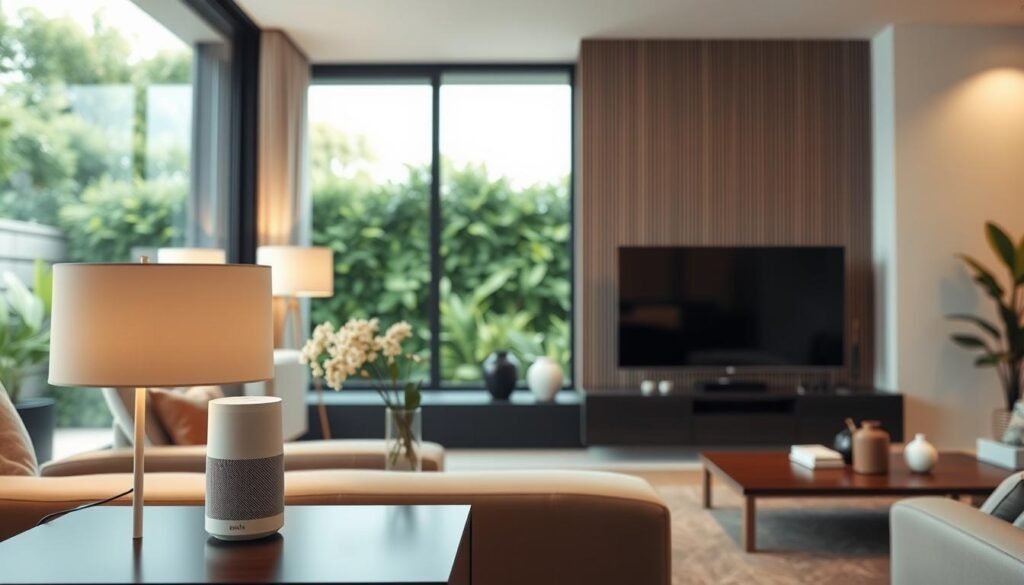The way we live is changing, and connected home technology is at the forefront of this revolution. With the rise of home automation, homes are becoming more convenient, secure, and energy-efficient.
Imagine being able to control the lighting, temperature, and security of your home from a single interface. This is now a reality with the integration of Smart Home Devices. These devices not only enhance the living experience but also contribute to a more sustainable lifestyle.
By embracing this technology, homeowners can enjoy a more streamlined and efficient living environment. The benefits are numerous, from increased security to energy savings.
Key Takeaways
- Smart Home Devices make homes more convenient and secure.
- Home automation contributes to energy efficiency.
- Connected home technology elevates the living experience.
- Integration of smart devices can increase home values.
- A more streamlined living environment is achieved through automation.
What Are Smart Home Devices?
Smart home devices are transforming our living spaces into intelligent environments that can be controlled remotely. These devices connect to the internet, allowing users to manage and monitor their homes through smartphones or voice commands.
Definition of Smart Home Devices
Smart home devices are part of a network of interconnected products that can be controlled, monitored, or automated remotely. They include a wide range of products, from smart thermostats and lighting solutions to security cameras and speakers. The key characteristic of these devices is their ability to connect to the internet, either through Wi-Fi or other wireless protocols, enabling remote access and control.
Some common features of smart home devices include:
- Remote monitoring and control through mobile apps
- Integration with voice assistants like Alexa or Google Assistant
- Automation capabilities to perform tasks based on schedules or triggers
- Energy efficiency and monitoring
Brief History of Smart Home Technology
The concept of smart home technology has evolved significantly over the past few decades. The first smart home devices emerged in the late 20th century, with early adopters focusing on home automation systems that could control lighting and temperature. However, these early systems were often complex and expensive, limiting their adoption.
The real turning point came with the advent of IoT devices and the widespread adoption of smartphones. As wireless connectivity became more prevalent, manufacturers began developing a wide range of smart home products that were more affordable and user-friendly. Today, smart home technology is more accessible than ever, with a vast array of devices available to suit different needs and budgets.
Benefits of Smart Home Devices
Smart home devices are revolutionizing the way we live by offering unparalleled convenience, enhanced security, and significant energy efficiency. By integrating these devices into our daily routines, we can simplify tasks, improve our home’s security, and reduce our energy footprint.
Convenience and Control
One of the primary benefits of smart home devices is the convenience they offer. With the ability to control lighting, temperature, and entertainment systems remotely through a smartphone app, homeowners can enjoy a more streamlined living experience. For instance, you can turn on the lights or adjust the thermostat before arriving home, ensuring a comfortable environment without wasting energy.
- Remote access to devices
- Voice control through smart assistants like Amazon Alexa or Google Assistant
- Customizable scenes and routines for different times of the day
Enhanced Security Features
Smart home devices also significantly enhance home security. With smart security cameras, doorbells with cameras, and smart locks, homeowners can monitor their property in real-time and receive alerts about suspicious activities. This not only deters potential intruders but also provides valuable evidence in case of a security breach.
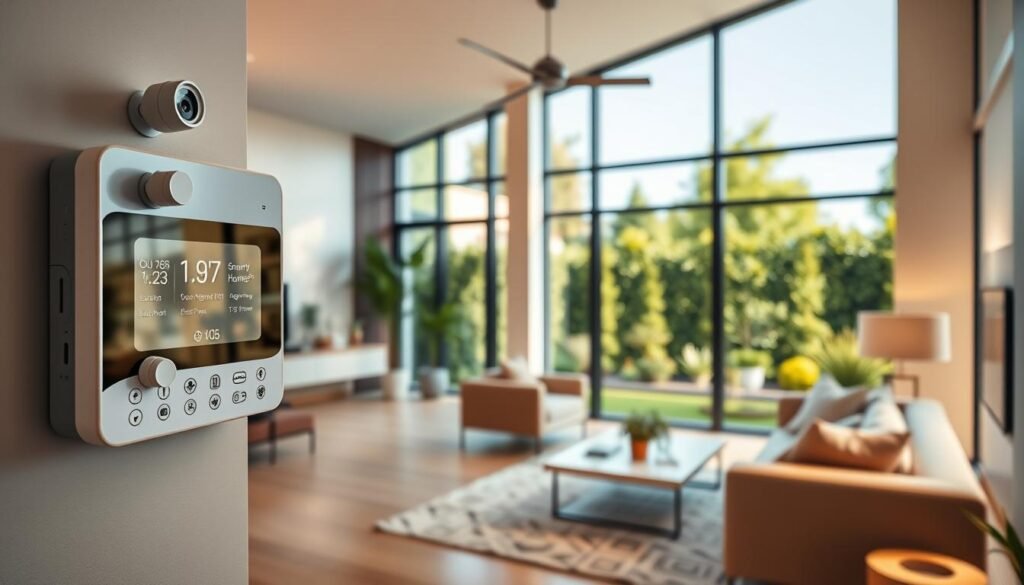
- Real-time video monitoring
- Motion detection alerts
- Smart lock systems for keyless entry and enhanced access control
Energy Efficiency
Smart home devices contribute to energy efficiency by optimizing the use of resources such as electricity and water. Smart thermostats, for example, learn your schedule and preferences to heat or cool your home only when necessary, reducing energy waste. Similarly, smart lighting systems can automatically turn off lights in unoccupied rooms.
- Smart thermostats for optimized heating and cooling
- Smart lighting systems for reduced energy consumption
- Smart plugs for monitoring and controlling the power usage of appliances
By embracing smart home devices, homeowners can enjoy a more convenient, secure, and energy-efficient living environment. As technology continues to evolve, the potential benefits of smart home systems are expected to grow, making them an increasingly valuable investment for homeowners.
Popular Types of Smart Home Devices
From smart speakers to intelligent lighting solutions, the options for smart home devices are extensive and diverse. These devices not only enhance the convenience and comfort of your home but also provide advanced security features and energy efficiency.
Smart Speakers
Smart speakers, such as Amazon Echo and Google Home, have become a central hub for many smart homes. They offer voice control, allowing you to manage other smart devices, play music, and get information on demand. With features like Alexa and Google Assistant, these speakers can integrate with a wide range of compatible devices, making it easy to control your smart home ecosystem.
Key Features of Smart Speakers:
- Voice control and smart assistant integration
- Multi-room audio capabilities
- Compatibility with various smart devices
Smart Thermostats
Smart thermostats, like Ecobee and Nest, learn your temperature preferences and adjust the heating and cooling of your home accordingly. They can help reduce energy consumption by optimizing the temperature when you’re not home or when you’re sleeping.
Benefits of Smart Thermostats:
- Energy savings through optimized temperature control
- Remote access to adjust temperature settings
- Detailed energy consumption reports
Smart Security Cameras
Smart security cameras provide real-time monitoring of your home, offering peace of mind whether you’re at home or away. Brands like Ring and Arlo offer high-definition video, motion detection, and alerts to your smartphone.
Features to Look for in Smart Security Cameras:
- High-definition video quality
- Motion detection and alerts
- Night vision capabilities
Smart Lighting Solutions
Smart lighting solutions, such as Philips Hue and LIFX, allow you to control the lighting in your home remotely. You can adjust brightness, change colors, and schedule lighting scenes to match different moods or activities.
- Customizable lighting scenes and schedules
- Energy efficiency through optimized lighting control
- Enhanced home security with automated lighting
In conclusion, these popular types of smart home devices can significantly enhance your living experience, providing convenience, security, and energy efficiency. By choosing the right devices for your needs, you can create a smart home that is both comfortable and sustainable.
How to Choose the Right Smart Home Device
The key to a successful smart home lies in choosing devices that meet your specific needs and preferences. With the vast array of options available, making an informed decision can significantly enhance your living experience.
Assess Your Needs
Before diving into the world of smart home devices, it’s essential to assess your needs. Consider what you want to achieve with your smart home system. Are you looking to enhance security, improve energy efficiency, or simply add convenience to your daily routine?
For instance, if you’re keen on home automation, you might want to explore smart plugs and lighting solutions that can be controlled remotely. On the other hand, if security is your top priority, smart security cameras and doorbells with cameras could be the way to go.
“The future of smart homes is not just about technology; it’s about how that technology makes you feel.”
Compatibility with Existing Devices
Ensuring that your new smart home device is compatible with your existing devices is crucial. You don’t want to end up with a device that can’t integrate with your current smart home ecosystem.
- Check if the device is compatible with your existing smart home hub or voice assistant.
- Consider the communication protocols used by your devices, such as Zigbee, Z-Wave, or Bluetooth.
- Look for devices that are part of the same smart home ecosystem or brand to simplify integration.
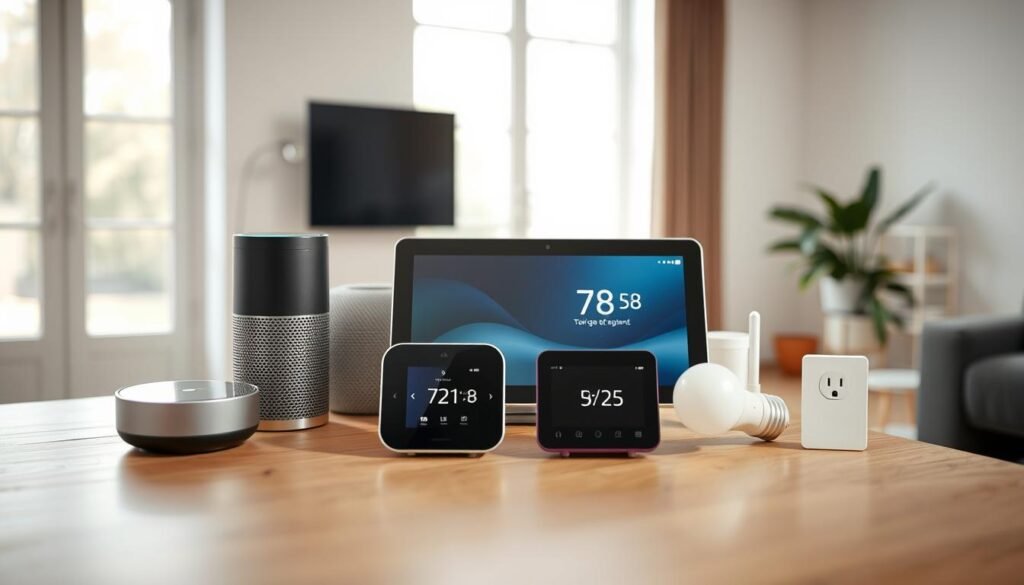
Budget Considerations
Smart home devices can range from relatively affordable to very expensive. Setting a budget before making a purchase can help narrow down your options.
Consider the cost per device and think about how many devices you’ll need to achieve your smart home goals. Look for budget-friendly options that offer the features you need without breaking the bank.
For example, smart light bulbs can be a cost-effective way to start your smart home journey, with many options available under $20.
Setting Up Your Smart Home Devices
With the rise of wireless home devices, setting up your smart home has never been easier. The process involves a few straightforward steps that can significantly enhance your living experience.
Initial Installation Tips
Before diving into the world of smart home technology, it’s essential to start with the basics. Begin by unpacking and physically installing your devices. For devices that require a power source, ensure they are plugged in and turned on. Some devices, like smart bulbs, may need to be screwed into existing light fixtures.
Key steps for initial installation:
- Unpack and inventory all devices and accessories.
- Follow the manufacturer’s instructions for physical installation.
- Ensure devices are powered on and ready for configuration.
Connecting to Wi-Fi
Connecting your smart home devices to your Wi-Fi network is a crucial step in the setup process. Most devices will require you to select your Wi-Fi network from a list and enter your network password. This step allows your devices to communicate with each other and with the cloud, enabling remote control and monitoring.
Tips for a smooth Wi-Fi connection:
- Ensure your Wi-Fi network is stable and functioning correctly.
- Place your router in a central location to improve connectivity.
- Use the device’s companion app to facilitate Wi-Fi setup.
Using Mobile Apps
Mobile apps play a central role in controlling and monitoring your smart home devices. After installing your devices and connecting them to Wi-Fi, you’ll typically need to download and install a companion app. These apps allow you to control your devices remotely, receive notifications, and adjust settings to suit your preferences.
| Device Type | Primary Function | Common Mobile App Features |
|---|---|---|
| Smart Speakers | Voice Control, Entertainment | Volume control, music selection, smart home control |
| Smart Thermostats | Temperature Control | Temperature adjustment, scheduling, energy usage reports |
| Smart Lighting | Lighting Control | On/off control, brightness adjustment, color changing |
By following these steps and utilizing the mobile apps associated with your devices, you can enjoy a seamless smart home experience that enhances convenience, security, and energy efficiency.
Integrating Smart Home Devices with Home Automation
The true potential of smart home devices is unlocked when integrated with home automation. This integration not only enhances the functionality of individual devices but also creates a seamless and efficient smart home ecosystem.
Understanding Automation Routines
Automation routines are the backbone of a well-integrated smart home system. These routines allow you to create customized scenarios that can be triggered by a single command or event. For example, you can create a “Good Night” routine that locks all doors, turns off lights, and adjusts the thermostat with a single voice command.
Benefits of Automation Routines:
- Simplifies complex tasks
- Enhances convenience and efficiency
- Improves home security
Voice Control and Smart Assistants
Voice control is a key feature of smart home automation. Smart assistants like Amazon Alexa and Google Assistant enable you to control your devices using voice commands. This hands-free control makes it easier to manage your smart home devices, especially when you’re busy or away from home.
Popular Smart Assistants:
- Amazon Alexa
- Google Assistant
- Apple Siri
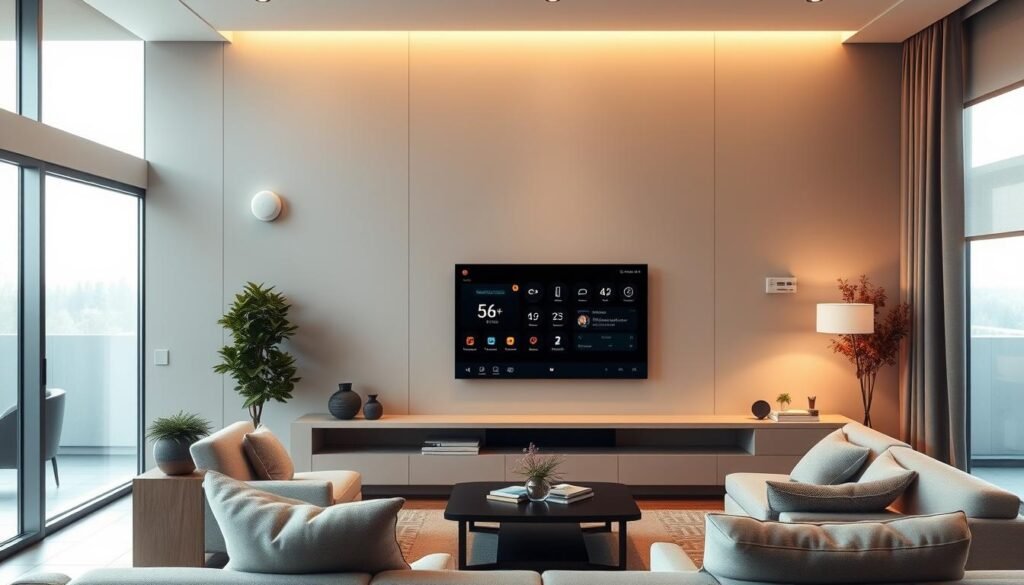
Scheduling and Remote Access
Scheduling and remote access are crucial features that allow you to manage your smart home devices more effectively. With scheduling, you can automate tasks based on time or events. Remote access enables you to control your devices from anywhere, providing peace of mind and greater control over your home.
Advantages of Scheduling and Remote Access:
- Energy efficiency through automated schedules
- Enhanced security through remote monitoring
- Greater convenience and flexibility
The Role of Smart Home Devices in Energy Management
Energy efficiency is a key benefit of smart home devices, which help in monitoring and controlling energy usage. By integrating smart technology into our homes, we can significantly reduce energy waste and lower our utility bills.
One of the primary ways smart home devices contribute to energy management is through monitoring energy consumption. Devices such as smart meters and energy monitors provide real-time data on energy usage, helping homeowners identify areas where they can cut back.
Monitoring Energy Consumption
Smart energy monitors can track the energy usage of individual appliances, providing detailed insights into consumption patterns. This information allows homeowners to make informed decisions about their energy usage and adjust their habits accordingly.
- Identify energy-hungry appliances
- Monitor energy usage in real-time
- Receive alerts for unusual energy consumption
For instance, a smart plug can be used to monitor and control a specific appliance, such as a refrigerator or washing machine. By understanding how much energy these appliances consume, homeowners can take steps to reduce their energy footprint.
Smart Plugs and Power Management
Smart plugs are another effective tool for managing energy consumption. These devices can be controlled remotely through a smartphone app, allowing homeowners to turn off appliances when not in use.
Some benefits of using smart plugs include:
- Remote control of appliances
- Scheduling energy usage
- Monitoring energy consumption of individual devices
Benefits for the Environment
The environmental benefits of using smart home devices for energy management are significant. By reducing energy consumption, we can lower our carbon footprint and contribute to a more sustainable future.
Some of the key environmental benefits include:
- Reduced greenhouse gas emissions
- Lower demand on power grids
- Increased energy efficiency
In conclusion, smart home devices play a vital role in energy management by providing insights into energy consumption, enabling control over appliances, and promoting energy efficiency. By leveraging these technologies, homeowners can make a positive impact on the environment while also saving on their energy bills.
Privacy and Security Concerns
As we embrace the convenience of smart home devices, it’s crucial to consider the potential privacy and security risks involved. Smart home devices, while offering numerous benefits, also raise significant concerns regarding data privacy and security.
Protecting Your Data
One of the primary concerns with smart home devices is the protection of personal data. These devices often collect sensitive information, including usage patterns and personal preferences. To protect your data, it’s essential to:
- Use strong, unique passwords for all devices and accounts.
- Enable two-factor authentication whenever possible.
- Regularly update device firmware to ensure you have the latest security patches.
Data encryption is another critical aspect of data protection. Look for devices that offer robust encryption methods to safeguard your information.
Secure Network Practices
Securing your home network is vital to preventing unauthorized access to your smart devices. Here are some best practices:
- Change the default administrator password on your router.
- Use a strong Wi-Fi password and enable WPA3 encryption.
- Set up a guest network for IoT devices to isolate them from your main network.
Regularly monitoring your network for suspicious activity can also help identify potential security threats early.
Choosing Trusted Brands
When selecting smart home devices, it’s crucial to choose brands that prioritize security and privacy. Research the brand’s reputation regarding:
| Brand | Security Features | User Reviews |
|---|---|---|
| Brand A | End-to-end encryption, regular updates | 4.5/5 |
| Brand B | Two-factor authentication, secure data storage | 4.2/5 |
| Brand C | Automatic security patches, robust password protection | 4.8/5 |
By choosing brands with strong security features and positive user reviews, you can significantly reduce the risk of privacy and security breaches.
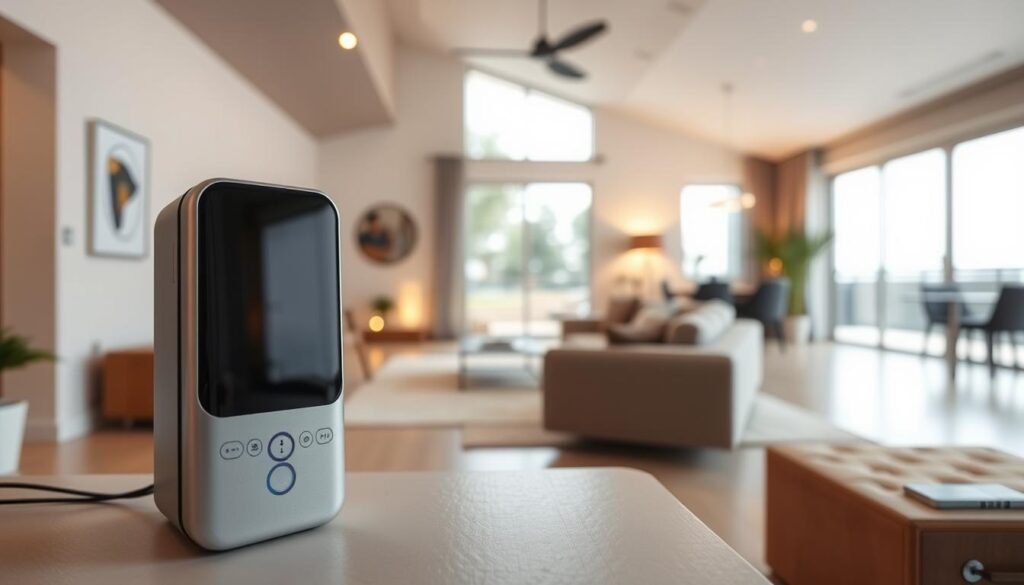
In conclusion, while smart home devices offer many benefits, addressing privacy and security concerns is essential. By protecting your data, adopting secure network practices, and choosing trusted brands, you can enjoy the convenience of smart home technology while minimizing potential risks.
Future Trends in Smart Home Technology
The future of smart home technology is rapidly evolving, with innovations that promise to revolutionize our living spaces. As we look to the horizon, several key trends are emerging that will shape the future of smart homes.
Innovations on the Horizon
One of the most exciting developments is the integration of Artificial Intelligence (AI) and Machine Learning (ML) into smart home devices. These technologies enable devices to learn from our behaviors and preferences, automating tasks and improving efficiency. For instance, AI-powered thermostats can adjust temperatures based on our daily routines, while ML algorithms can optimize energy consumption by identifying patterns in our usage.
The Impact of AI and Machine Learning
The impact of AI and ML on smart home technology cannot be overstated. These technologies are not only enhancing the functionality of smart devices but also making them more intuitive and user-friendly. For example, voice assistants like Amazon Alexa and Google Assistant are becoming increasingly sophisticated, allowing for more complex commands and integrating with a wider range of devices.
Moreover, AI-driven analytics can provide valuable insights into our energy consumption patterns, helping us make more informed decisions about our energy usage. This can lead to significant cost savings and a reduced carbon footprint.
Smart Cities and IoT Integration
The concept of Smart Cities is gaining traction, with smart home technology playing a crucial role in this vision. The integration of IoT devices is enabling cities to become more efficient, sustainable, and livable. Smart home devices are being connected to broader city infrastructure, allowing for a more cohesive and integrated approach to urban planning and management.
For instance, smart lighting systems can be integrated with traffic management systems to optimize traffic flow and reduce congestion. Similarly, smart energy grids can manage energy distribution more efficiently, reducing waste and lowering emissions.
As we move towards a more interconnected future, the potential for smart home technology to contribute to the development of smart cities is vast. By embracing these innovations, we can create more sustainable, efficient, and livable environments for everyone.
Customer Testimonials and Success Stories
Many customers have experienced significant improvements in their daily lives thanks to smart home devices. From enhanced convenience to increased energy efficiency, the benefits are clear.
Lives Transformed by Smart Technology
Real-life examples illustrate the positive impact of smart home devices. For instance, smart thermostats have helped homeowners reduce their energy bills, while smart security cameras have provided peace of mind.
Customer testimonials highlight the success stories of those who have integrated smart home devices into their lives. “Smart home devices have revolutionized my home,” says one satisfied customer. “I’ve seen a significant reduction in my energy consumption and feel more secure with the smart security cameras.”
Community Insights and Recommendations
Community feedback is invaluable in understanding the effectiveness of smart home devices. By gathering insights from customers, we can better understand what works and what doesn’t, ultimately leading to improved products and services.
As smart home technology continues to evolve, customer testimonials and success stories will remain essential in shaping the industry. By sharing real-life experiences, we can inspire others to explore the benefits of smart home devices.
FAQ
What are smart home devices?
How do smart home devices connect to the internet?
What are some benefits of using smart home devices?
What are some popular types of smart home devices?
How do I choose the right smart home device for my needs?
How do I set up my smart home devices?
Can I integrate my smart home devices with home automation systems?
How can smart home devices help with energy management?
Are there any security concerns with using smart home devices?
What are some future trends in smart home technology?
Can smart home devices really improve my life?
Prabir Dutta
Prabir Dutta is a passionate digital creator, affiliate marketer, and wellness enthusiast who simplifies complex topics like AI tools, Vastu, pet care, and modern living. With a keen eye for SEO, tech trends, and everyday health solutions, he writes to empower readers with actionable, smart-living insights. When not curating content across his network of niche blogs, Prabir enjoys exploring new digital tools that make life easier and more efficient.

